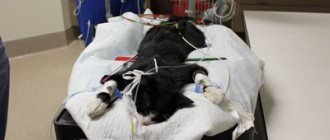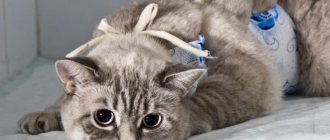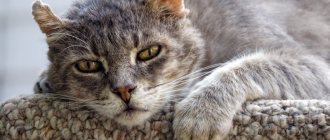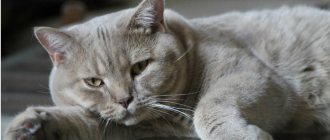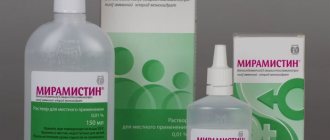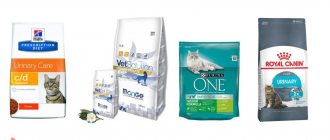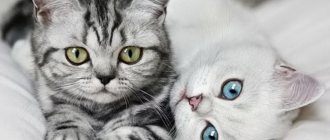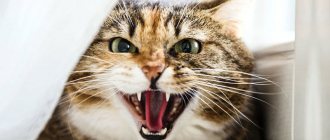Sterilizing a cat is only half the process. The most important and responsible period begins after the operation, when caring for the animal is the responsibility of the owner himself. Before returning the cat to the owner, the veterinarian is required to provide instructions on the specifics of care during the postoperative period. You definitely need to know how seams are processed and what to do if an extreme situation arises. After sterilization of a cat, care is a very important process.
The first hours after surgery
Sterilization lasts no more than 30 minutes, after which the animal can be taken home. At this time, the cat may still be under the influence of anesthesia. The duration of anesthesia depends on the dosage of the drug, the characteristics of the animal’s body, and the conditions for preparing the cat for the procedure. The most important thing during transportation is to provide the pet with warmth, wrap it in a blanket, and transport it in a warm car without a draft. Involuntary urination may occur during sleep, so you need to have a moisture-absorbing diaper.
When the animal comes out of anesthesia, the owner should be nearby. Cats are smart animals, they get offended if they are abandoned when they feel bad. In addition, during the first three hours you need to:
- provide the pet with absolute warmth;
- do not allow the cat to climb onto high places;
- do not lose sight of the animal, constantly monitor it;
- if necessary, apply eye drops;
- provide peace;
- if necessary, lay on the right side.
The owner must be nearby during the animal's recovery from anesthesia.
Rules for processing postoperative sutures
How to perform this procedure correctly?
First of all, there is no need to rush. Secondly, you must strictly follow the instructions below:
- First, you need to moisten a cotton-gauze swab or just a gauze swab with an antiseptic composition, and then, without making sudden movements, wipe the seam along the edge, removing dried ichor and other contaminants.
- It is not advisable to wipe the surface of the seam; it is recommended to do this only if it is very dirty. It is better to apply antiseptic ointments and similar dosage forms directly to the seam.
- All skin folds in the suture area must be thoroughly smoothed and washed with an antiseptic. Dirt accumulates in them, and pathogenic microflora actively develops there.
- In addition, veterinarians advise treating the seam while the cat is standing. This approach reduces the likelihood that part of the antiseptic composition will get deep into the wound canal.
Advantages and disadvantages of inpatient monitoring
Most veterinary clinics provide the opportunity to leave the animal after surgery while it comes out of anesthesia or for a few days before the stitches are removed. This useful service has not only advantages, but also disadvantages.
Positive factors include the following:
- prevention of hypothermia of the animal during transportation, especially in the cold season;
- Saving time for busy owners to care for their pet;
- preventing the development of complications due to improper care;
- ensuring qualified management of the animal after surgery, which is especially important in the presence of pathologies.
Disadvantages of inpatient monitoring:
- a stressful situation for an animal in an unfamiliar environment;
- lack of guarantees regarding the conscientious performance of their duties by employees and a friendly attitude towards the cat;
- high cost of keeping a pet in the clinic.
General information about the procedure
Sterilization is an operation that results in the removal of the uterus and ovaries in females and testes in males. It would be more correct to call the procedure castration, however, to soften the perception of owners, the concept was replaced by the term sterilization. As you know, a fairly large number of owners vehemently oppose the sterilization of pets, but they are guided mainly by common myths.
Let's figure out what changes in the animal's behavior to expect immediately after surgery and after a long period of time. As part of the questions, it is worth touching on the myths that frighten inexperienced owners and make them refuse to castrate their pets.
This is an abdominal operation that is performed under general anesthesia. In large, modern veterinary clinics, the procedure is performed laparoscopically. The advantages of the laparoscopic method are that there is no suture; the uterus and ovaries are removed through two small punctures in the peritoneum. Since laparoscopic surgery is considered expensive, most owners opt for strip surgery.
To avoid serious complications, before sterilization, it is recommended that the cat be examined for heart, kidney and liver failure. Serious complications can be caused by immunodeficiency, exhaustion, dehydration and other disorders leading to suppressed immunity or slowed metabolism.
Note! A common British cat breed, it is considered prone to congenital cardiomyopathy. Before castration of purebred animals, it is strongly recommended to take a blood test and conduct an ultrasound examination of the heart.
Caring for a cat during the recovery period
Transportation should be calm, soft and warm. In addition to blankets, you can use a heating pad or a bottle of warm water. The pet should be placed on a hard surface on its right side, after laying down an oilcloth or moisture-absorbing diaper. Before transporting your cat after surgery, you need to make sure there is no bleeding.
General condition of the house
If the hospital did not give your animal pain relief after surgery, you can give the injection at home after consulting with your veterinarian. Tablets should not be given during this period. It is necessary to use a blanket - a special protective bandage that prevents injury to the seams and the cat licking them.
It is mandatory to use blankets at home
The animal should be placed in a warm, quiet place, for example, on the floor on a bedding or left in a carrier if it is spacious. You should not place your pet on a chair or other elevated surface, as it may fall due to poor coordination and possible restlessness after anesthesia. There is no need to place heating devices nearby; it is better to use a heating pad. Every 30 minutes the animal must be turned over to the other side.
Processing and removal of seams
During the recovery period, the seams should be protected with a blanket. Treatment is carried out as directed by the doctor an hour after pain relief, and then on the 2-3rd day at intervals specified by the doctor. Until the fifth day, a slight discharge of ichor is allowed. The stitch may be red and raised above the skin.
On the fifth day, the seams should be dry, without swelling and redness, and the edges should fit tightly to each other. Otherwise, you need to go to the clinic. If the doctor used self-absorbing threads, then there is no need to remove the sutures. When using regular suture threads, the seams should be removed after 7-10 days. To do this, the pet is taken to the clinic or an agreement is made with the doctor to carry out the procedure at home.
Food and drink
The first day the animal has no appetite, urination is more scanty than usual. It is important to provide the animal with water immediately after recovering from anesthesia; you can give it from a syringe without a needle. Feed the pet the day after surgery, reducing the portion to 1/3 of the usual volume. Since the intestines are weak at this time, constipation is possible, so you need to control that the cat’s nutrition is correct. If there is no bowel movement for three days, Vaseline oil is given at the rate of 5 ml per 5 kg of body weight every 8 hours.
Gradually the animal is transferred to food for sterilized cats
You can purchase special food intended for use specifically after this operation. It is produced by Royal Canin and Eukanuba. Gradually, over the course of a month, the animal is transferred to food for sterilized cats.
Removal of the reproductive organ can lead to obesity, which negatively affects overall health. Therefore, a low-calorie diet and avoidance of usual treats are recommended.
Eye care
During the effect of anesthesia, the animal's eyes remain open. To prevent the cornea from drying out, you need to forcefully close the cat’s eyes every half hour and use special moisturizing drops. It is allowed to use 0.9% saline solution.
When to castrate a cat
Castration is a surgical procedure in which an animal's gonads are removed. It is recommended to castrate cats at the age of 8–12 months, when puberty ends. After castration, animals are not capable of reproducing offspring, their signs of sexual behavior disappear, and their aggressiveness decreases.
Most often, owners decide to castrate a cat so that the cat does not mark in the house, and also hoping to reduce the aggressiveness of the animal. Sometimes castration is necessary for medical reasons (orchitis, trauma, pathologies of the development of the gonads). It is believed that this operation prevents the development of diseases such as prostatitis, prostate tumor, and perianal gland adenoma in adult cats.
Medicinal support
If the animal will be at home during the postoperative period, you need to stock up on some medications.
Painkillers and restoratives
Before using any medications, you should first consult your doctor.
During the rehabilitation period, the following painkillers are used:
- "Rimadyl." Administer intravenously or subcutaneously at 4 mg/kg 1 time per day.
- "Tolfedine" (tolfenamic acid). 4 mg/kg 1 time per day with food.
- "Ketofen." It is administered subcutaneously, intramuscularly or intravenously at 2 mg/kg once a day and no longer than 3-4 days.
- Loxicom. 0.1 mg suspension/kg orally on the first day once, 0.05 mg/kg on subsequent days.
For general strengthening of the animal’s body, “Gamavit” is used. The first 2-3 days, 0.5 ml/kg of body weight, then up to two weeks, 0.1 mg/kg.
"Rimadyl" "Tolfedine" "Ketofen" "Loxicom"
Seam treatment products
- "Chlorhexidine 0.05%." Water the seam or drip from a pipette until it heals.
- "Dioxidine 0.5%". Used similarly to Chlorhexidine.
- "Veteritsin-spray". The stitches are sprayed up to twice a day until removed.
- "Aluminium spray". Spray the seams several times a day.
- "Chemi-spray." Use once a day until healing.
- "Levomekol" ointment. Apply a thin layer around the wounds once a day.
Antibiotics
The following antibacterial drugs are used as prescribed by a doctor:
- "Sinulox". Administer intramuscularly once a day, 0.5 ml/10 kg for 3-5 days.
- "Amoxicillin 15%." Administered subcutaneously or intramuscularly at 1 ml/kg (15 mg/kg) once a day for 5 days.
"Amoxicillin 15%" is administered subcutaneously or intramuscularly
Hemostatic agents
To stop bleeding the following is prescribed:
- "Travmatin" - intramuscularly or subcutaneously 0.5-1 ml 2-5 times a day;
- "Etamzilat" - 0.1 ml/kg twice a day.
Gymnastic exercise set
For 2-3 weeks after surgical removal of a hernia in the groin, you must refrain from any physical activity so as not to create excessive stress on the walls of the inguinal canal. When the postoperative scars have healed, you can begin physical rehabilitation.
The load should increase gradually. First, the patient performs light, mostly passive movements. If there is no pain or any discomfort when performing light exercises, the degree of load increases. During rehabilitation after removal of an inguinal hernia, the following exercises are performed:
- "Scissors";
- "Bike";
- stand on all fours with emphasis on your elbows, alternately lift your right leg bent at the knee, then your left, perform 5-10 lifts on each leg;
- lie on your side, legs straight, extended, lift your leg up 10-15 times, then turn around and repeat with the other limb;
- shallow squats with feet shoulder-width apart. The load should increase gradually. First, the patient performs light, mostly passive movements.
If during the exercises a person notices the appearance of pain, the exercise should be stopped immediately and the doctor should be informed about the incident. If the patient was involved in strength sports before surgery, for example, bodybuilding or powerlifting, it will be possible to return to training no earlier than after 3-5 months.
First week day by day
Rehabilitation at home requires compliance with certain instructions over several days:
- Day 1. The animal needs to be provided with peace and warmth, not placed on a hill. Do not feed, force water in small doses. Make sure your cat has bowel movements. Monitor the condition of the cornea. If vomiting begins, keep the animal on its side. Disorientation and anxiety of the animal are normal after anesthesia.
- Day 2. Feed in small portions, despite a good appetite. Broth and biokefir are allowed. Protect from drafts, use a blanket. As prescribed by the doctor, the animal is given painkillers for the first two days.
- Day 3. The pet begins to show interest in its surroundings. You need to monitor your temperature and contact your doctor if it is elevated or low. If there is no stool, a laxative is given. You should not overfeed an animal not only after surgery, but also in the future to prevent obesity.
- Day 4. The cat eats and drinks independently, goes to the litter box. If urination is impaired, give “No-shpa” or valerian tincture at the rate of 2-3 drops per 1 tsp. water, massage the abdomen. If this does not help, you need to go to the clinic and have a catheter inserted.
- Day 5. It is allowed to lift the restriction on movement around the apartment and give access to all rooms. By this time, the redness and swelling of the stitches should disappear.
- Days 6 and 7. By the end of the first week, the animal regains its former activity, jumps on heights, eats and drinks as usual, and goes to the litter box. The only reminder of the operation is the blanket, which prevents the cat from moving normally.
If the recovery period is normal, the sutures are removed on days 7–10.
The sutures are removed at approximately 7-10 days
What to do if the cat does not allow the seam to be processed?
It happens that the pet (especially in the first day after sterilization) is not allowed into the hands and resists when the owner tries to treat the seam. At this time, the animal still experiences unpleasant sensations, which explain the outbursts of aggression.
And if the cat does not allow the seam to be processed, you need to do the following:
- If the animal is strong, it is advisable to use mild sedatives and painkillers.
- A surgical collar is required. It will prevent the animal from scratching the owner, as well as from tearing the interfering seam later.
- In the most severe cases, you have to “swaddle” the cat using a sheet or pillowcase, and then inspect and treat the seam on its stomach.
In addition, it won’t hurt to talk to your pet, pet it more often and calm it down. If the cat gets used to the daily treatment of seams, then it will be much calmer about it. When processing, you do not need to make sudden movements; you should not press too hard on the tampon.
What are the possible postoperative complications?
You should consult a doctor if you experience the following symptoms:
- low temperature (below 37 °C) on the second day after surgery;
- bleeding from stitches and vulva;
- temperature rise above 39 °C;
- hyperemia, rotting, swelling of the sutures on the 6th day;
- the formation of a lump in the area of the seams.
Complications include fever above 39 °C
Feeding a sterilized pet
It is not recommended to feed your pet in the first hours after anesthesia. After sterilization, many people experience impaired swallowing reflex, which makes eating difficult. During this period, food can cause vomiting, so at first some cats have to be given water from a pipette. The first meal should not exceed 50% of the usual norm.
On the 3-4th day the pet begins to eat fully. After sterilization, the cat's diet should be reviewed to avoid obesity. Therefore, the diet of such an animal should consist of meat, fermented milk products, the fat content of which does not exceed 5%, rolled oats, rice porridge, as well as fruits and vegetables.
For sterilized cats, veterinarians advise purchasing special food. The nutritional value of the product and calorie content are balanced in them. This feeding will give your pet the necessary energy and help maintain health for many years.
What not to do after sterilization
Complications can arise due to improper handling of the animal. For the first time after surgery you cannot:
- pull the pet by the front legs;
- grab by the stomach;
- play with the animal, provoke physical activity;
- force you to eat on the day of surgery;
- remove stitches yourself;
- allow the animal to get into the dirt;
- let the cat near the heaters;
- treat seams with iodine or brilliant green.
Sterilization is a common operation that requires simple preparation and rehabilitation. However, this is a full-fledged surgical intervention, so you need to properly care for the cat, following all the doctor’s advice. Improper care can cause serious complications, including the death of the animal.
Recommended Posts
Pros and cons of castration and sterilization of Chihuahuas
How is declawing done in cats and is it worth it?
What you need to know about the timing and organization of dog sterilization
What care does a dog need after spay and neuter surgery?
What are the benefits of feeding a cat after sterilization?
What you need to know before purchasing a Karelian-Finnish Laika
How to treat the seam?
The following compositions can be used to treat a postoperative wound and the tissue around it:
- Miramistin.
- You can treat the seam with chlorhexidine. It is even preferable to the previous option, since the composition has a better antiseptic effect.
- The skin around the seam can be treated with regular alcohol tincture of iodine and brilliant green. The main thing is not to pour these compounds into the wound channel!
- The surface of the seam can and should be treated with levomekol. This is an ointment with a pronounced bactericidal effect. In addition, the composition of dense consistency prevents debris and microflora from entering the wound channel.

